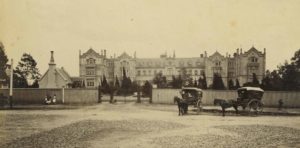George Wright, his wife and two small children arrived in Ballarat in 1857 from their native Cornwall. The stories of fortunes to be found had lured them to the goldfields. George looked unsuccessfully for gold and then for any kind of work that was available. Discouraged and poverty stricken he committed suicide.
His wife was left with no means and two small children to care for. There were no pensions and no sick relief. The Cornish community in Ballarat realised her plight, so they united and raised funds through an appeal. This is how the Ballarat Benevolent and Visiting Society was formed in November 1857. There were twenty-eight members on the committee. The poor were visited in their homes, and relief was offered to the sick and aged.
The Ballarat Benevolent and Visiting Society was the forerunner of the Ballarat Benevolent Asylum.
The Government granted 5 acres of swampy Crown Land for the Ballarat Benevolent Asylum and the foundation stone was laid on 17 March 1859. The Star reported that it was ‘situated at the corner of Eyre Street and a street as yet un-named’, that it was ‘a credit to the locality’, and would ‘not be much inferior to any similar erection in all the colonies’. One of the first patients was James Miller, a Scottish miner, aged 65 years who was admitted on 21 February 1861.
By the early 1860s the Ballarat Benevolent Asylum was catering for orphaned children, the aged and infirm, and maternity cases. The Common School at the Asylum operated from 1861 to 1868 and usually accommodated more than 60 children. The Benevolent Asylum was still supporting outdoor cases. In 1869 £323.16.4 was paid to support Ballarat’s Chinese lepers. Clothing, bedding and firewood was supplied and their huts were made more comfortable until a Lazarette was built.
The first Benevolent Asylum was built in Eyre Street in 1859 at a cost of £3765 The architect was Mr. Porter from Geelong who designed the Elizabethan styled building, made of brick with slate roof. There were many problems with the building. There was no ventilation apart from the windows and the lack of height in the dormitories was described as a ‘serious evil’.
Part of the original building has been demolished to make way for new buildings. The complex is now known as the Queen Elizabeth Centre complex and is under the auspices of Ballarat Health Services. It is now one of the leading centres in Australia for aged care.
Photograph (right) Ballarat Benevolent Asylum, State Library of Victoria
